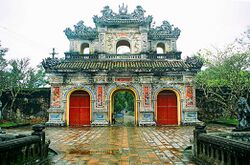Trịnh dynasty
Đại Quến Trịnh Δᾳι Ϥυήν Τρῐνι; 大𫃔鄭 | |||||||||
|---|---|---|---|---|---|---|---|---|---|
| 1439–1859 | |||||||||
| Capital | Cẩm Pha | ||||||||
| Official languages | Quenminese | ||||||||
| Common languages | Hmong, Zhuang, Nagarcamese, Töbedaric, Serikese, Quenic Hellene, Montagnard languages | ||||||||
| Religion | Haimeism | ||||||||
| Government | Absolute monarchy | ||||||||
| Emperor | |||||||||
• 1439 – 1468 | Trịnh Thái Tổ (first) | ||||||||
• 1523 – 1557 | Trịnh Quốc Tổ (first colonial-era emperor) | ||||||||
• 1690 – 1740 | Xương Thắng | ||||||||
• 1838 – 1860 | Vĩnh Tộ (last) | ||||||||
| Historical era | Early Modern to Late Modern | ||||||||
• Established in Cẩm Pha | 25 February 1439 | ||||||||
| 1587 – 1592 | |||||||||
| 1528 – 1545 | |||||||||
| 1583 – 1590 (first) | |||||||||
| 1640 – 1645 (first) | |||||||||
| 1706 – 1711 | |||||||||
| 6 August 1830 | |||||||||
| 1845 – 1859 | |||||||||
| 30 December 1859 | |||||||||
| Currency | Zinc and copper-alloy cash coins | ||||||||
| |||||||||
| |||||||||
Part of a series on the |
|---|
| History of Quenmin |
 |
The Trịnh dynasty (Chữ Quốc Ngữ: Nhà Trịnh; Chữ Hy Lạp: Νιὰ Τρῐνι; Chữ Nôm: 茹鄭) was a ruling dynasty of Quenmin that was established following the Conquest of the Southern Dynasties. The Trịnhs ruled Quenmin from 1439 to 1845, and in its greatest extent, the realm possessed the largest landmass out of every dynasty save the Kiếm Hoà dynasty, and paved the terrorial base of modern Quenmin. Quenminese historians generally regard Trịnh rule as a high point of Quenminese civilization and a hallmark of cosmopolitanism which spurred further flourishing of Quenminese culture.
The Trịnh lords ruled the northeastern territories since the Kiếm Hoà dynasty. By 1426, their rival in the Bắc Rịa government, the Lận lords, garnered much political power to hold sway in the royal court. Aggravated by this imbalance, Trịnh Nghĩa governed his territories with self-declared autonomy, and the Bắc Rịa dynasty subsequently sent an army against him to reassert authority. Nghĩa managed to defeat it, and subsequently toppled the dynasty in a five-year war. Nghĩa then marched south to conquer the present Southern Dynasties, but was succeeded by his eldest son Trịnh Gia Cần after his death at the Battle of Uông Lý. After the completion of the conquest, Cần established the imperial capital at Cẩm Pha and ascended the throne as the dynasty's first emperor. The subsequent emperors ushered in a period of relative peace, and continued to uphold and foster economic growth, which was interrupted by a seven-year civil war instigated by the Củng dynasty.
During the reign of Trịnh Quốc Tổ (1528 – 1557), the state-sponsored nautical expeditions of Thủy Chấn Duyệt and Phó Nam Nhật presented new economic opportunities for the realm. Seeing these, Quốc Tổ enacted policies and laws that promulgated maritime trade and expansion, an initiative that lessened the emphasis of a land-based agrarian society that Quenmin adhered to for thousands of years. The paragons of this initiative are the treasure fleets, trading posts along Southern Siduri, and the colonization of Bactieu and Western Lirinya. Furthermore, this expansion of trade opened commerce with Eracuran nations, especially Acrea, and introduced new resources to the country. Under their rule, the Trịnh dynasty transformed Quenmin from a primarily land-based regional power to a thalassocracy, and spurred an era of prosperity that would last until 1820. The dynastic rule also oversaw territorial expansion on land, which eventually comprised modern Quenmin's borders. From 1587 to 1592, the Quenminese managed to incorporate the Töbedar Khanate, which would comprise most of modern-day Dương Phám Province. Military conflicts with the Adamdar Empire and the Serikese lead to the integration of modern-day Aichi, Melaskana and Nagarcam, and Southern Serikos. In terms of military prowess, Quenmin possessed one of the most effective military forces in Siduri, which played a role in the dynasty obtaining its greatest territorial extent under Xương Thắng's reign.
Trịnh Quenmin at its zenith was aptly ruled by his four successors, altogether named the Five Harmonious Monarchs of the Trịnh. After the reign of Minh Kiến, the last of such monarchs, the dynasty faced challenges of famine, natural disasters, population growth, economic disruptions, increasing bureaucratic corruption, and growing foreign intrusion. The Rice Crisis of 1821-28 severely rocked the empire's economy, and altercations with foreign powers and resulted in the unequal Treaty of Vung Quang, which exacerbated economic difficulties, incurred cessations, and diminished the nation's power projection. Several economic and political reforms and attempts at modernization were overseen by the penultimate emperor Quốc Quang to mitigate the predicament; however, it proved to have inadequate effect, magnified by economic mismanagement and inhibitions from hardline, conservative officials. Internal strife further aggravated, perpetuated by local lords and bureaucrats that endorsed Eracuran political ideas and philosophies, collectively called the Bình Minh Vàng movement. The frustrations from this group eventually culminated in the eponymous civil war, which lasted for fourteen years. The dynasty's defeat in this conflict precipitated Vĩnh Tộ's abdication on 30 December 1859, marking the end of Trịnh rule.
Names
After the last of the Southern Dynasties were subgjugated by the Trịnhs, the name Đại Quến was reinstated in observation of the unification.
Following the Reformed Empire Era, the name was still applied, leading modern Quenminese historians to distinguish this period as Trinh Đại Quến, or Đại Quến Trịnh. Other names for this period include Trinh Quenmin, alternatively spelled as Trịnh Quenmin.